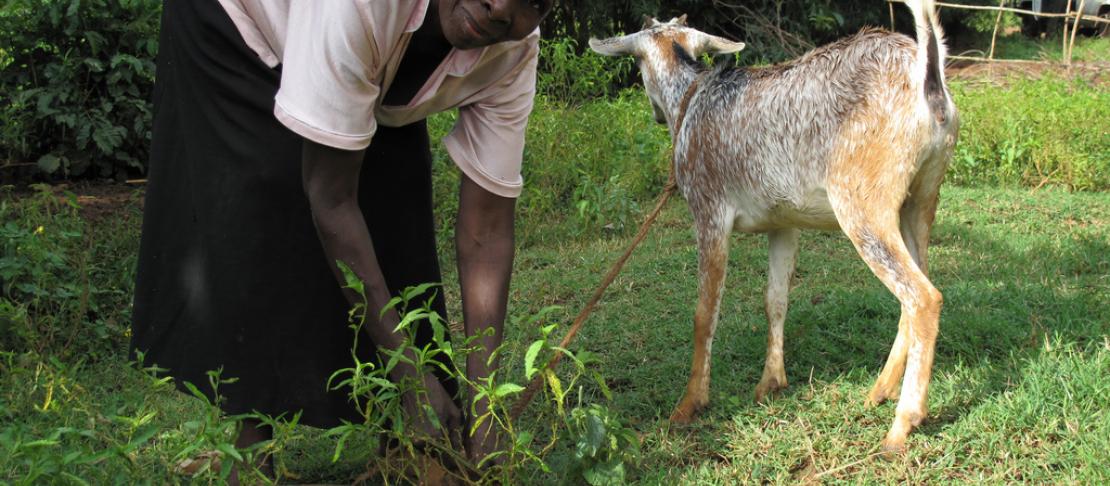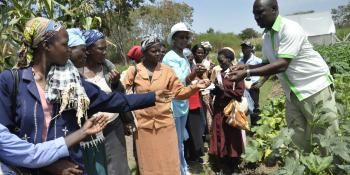Communicating behavior change: how a Kenyan TV show is changing rural agriculture

Farmers need innovative ways to get information about agriculture, and the TV-show Shamba Shape-Up is doing just that. Using information from its partners, us included, the show presents the information to farmers through fun, interactive and engaging ways. But is the show really making a difference?
How can we best assist farmers adapting to climate change? One of our ongoing strategies to achieve success has been to work in partnerships. By collaborating with partners the likelihood of us learning new approaches to disseminate climate information or discover innovative and climate-friendly agriculture practices is much greater. This is one of the reasons why we are working with Shamba Shape-Up in East Africa.
Shamba Shape-Up is a farm make-over program - but with a twist! In each episode, the team visits smallholder farms and addresses the biggest challenges faced by farmers. Using information from its partners, such as the CGIAR Research Program on Climate Change, Agriculture and Food Security (CCAFS), the show presents the knowledge to farmers through broadcasted shows.
Climate change is proven to be a major issue among farmers
"Farmers don't know much about climate change, they don't know when to plant, or what is happening to their crops," says Tonny Njuguna, presenter on the Shamba Shape-Up series. “All the farmers we visited have commented on the unreliability of the weather - usually the pattern of the seasons changing and there being too much rain in too short a time, at the wrong time.”
Therefore, the aim of the show is to give farmers the help and knowledge they need to improve their farming methods, despite climate change, increase their income and turn-around their farms into good business for the future.
The Shamba Shape-Up show is now starting its fourth season:
New #SSU series via @shambashapeup starts this weekend 15th &16th March - Tune in for #realityTV with an educational twist @citizentvkenya
— CCAFS cgiarclimate (@cgiarclimate) March 11, 2014
New way to receive vital information about crops and livestock
The program is revolutionising the way its 11 million viewers are getting their agricultural information. Rather than addressing future climate problems through overly technical language, the program addresses the issues that farmers face day-to-day and promote adaptations that have both short-term and long-term benefits.
For example, in a visit to Rongai, Kenya, the SSU team teach farmers John and Miriam about the value of harvesting rainwater by making use of gutters and water tanks. In areas where rainfall is erratic and unpredictable, water harvesting is particularly important for farmers who are forced to walk miles to get sufficient water. As weather patterns are expected to become even more unpredictable, water harvesting is a good short and long-term adaptation option.
Watch the episode from Rongai, Kenya:
A changed behaviour could mean a change in income
A recent 2013 study, commissioned by the Africa Enterprise Challenge Fund (AECF), explores whether the program contributed to actual behavior changes.
The study, which used questionnaires and follow up face-to-face surveys of smallholder farmers, found that 98% of viewers reported having learned something new, such as new techniques in cattle and dairy cows rearing to practices that improve soil quality.
Results like this highlight the power that education-cum-entertainment programming can have in promoting technical adaptation and on-farm innovations.
But what does learning mean in terms of changing behavior? The same study found that nearly 87% of the viewers also incorporated the new practices they learned onto their farms. When considering a growing secondary audience of farmers who learn about SSU through word of mouth (perhaps from family, neighbors or friends), the link between information and spreading of innovation can be quite dramatic.
In addition to adaptation of new technologies, one of the most interesting results of the AECF study was on the program's impact on farm incomes and benefits. The survey reported that 53% of participating maize farmers made changes to their soil fertility. The soil management practices cost around 58.8 USD per household but resulted in a median seasonal increase of 82.4 USD.
Similarly, 54% of participating cattle farmers reported that after watching SSU, their median investment in dairy production practices was 117.6 USD and resulted in an increase of 58.8 USD per month in income.
Get report: Shamba Shape Up series one development benefit and systemic impact

via the tv show shamba-shape up, Farmers learn new farming practices that can improve on-farm production and their incomes, while adapting to climatic changes. Photo: C. Pye-Smith (ILRI)
Social Learning: key to success
Social learning approaches to sharing and receiving knowledge are likely a major factor in the credibility and success of the program. For example, each episode features hosts that interview real farmers on their agricultural problems to generate feedback on farming experiences and on using improved technologies.
Scientists from the Kenya Agricultural Research Institute or from international research agencies like ICRISAT are often guests on the show who visit farms and discuss practical constraints of farmers and explain options for improve agricultural practices. Whether discussing how to practice better agronomy, diversify crops or how to improve storage after harvest, a combination of farmer testimonials and expert input lend credibility to the new ideas on the show.
Change however is driven from the grassroots level and Shamba Shape-Up knows this. Most of the proposed farm improvements are economically feasible for extremely poor farmers.
Where possible, the show recommends that farmers use resources that they have on their farms, such as manure and food waste. Putting scientific information into relevant and practical, but also entertaining, terms for farmers is much more effective at getting farmers to try innovations.
A growing audience
Every year, more and more farmers are getting access to televisions. From 1998 to 2004, television use in rural areas grew from 36 per cent to 64 per cent. Where television isn’t accessible, Shamba Shape-Up has SMS service and paper pamphlets for farmers. By providing readily accessible information from different platforms, Shamba Shape-Up tries to reach as many farmers as possible.
There is a lot more that can be learned, both for farmers and for us. Already we know that soil fertility adaptations and livestock rearing adaptations are the most popular among farmers. Further surveys will teach us more about which adaptations work and why. Answers to these questions can be used to direct research in the future.
Learn more about this partnership:
- Farmers get latest solutions for climate 'shape-up
- Kenyan farmers use climate 'entertainment' for empowerment
- Interview: Successful 'fast-food' agricultural knowledge in the making
Nafisa Ferdous works as a Gender and Social Learning Consultant for CCAFS Linking Knowledge with Action theme. Manon Verchot joined the team as an intern last year.



